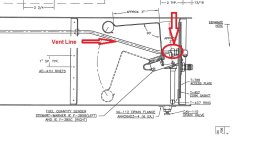Carbureted O-360-A2A.
My fuel tanks - right more than left - if the caps are left on tight, will often “whoosh” air in or “poof” air out when the caps are removed. The more fuel in the tanks, the worse it is. They occasionally dribble out the drains, but not a lot and not always. The person I bought it from says the owner previous to him had the tanks resealed at some place that advertised that for RV tanks, and that it’s done this sucking and blowing ever since then, but not before.
My suspicion is that there’s ProSeal in the vent line, or maybe the end of the vent line isn’t bent upward enough to keep it out of the fuel when the tanks are full.
I’m at a loss as to how to troubleshoot this, short of opening the tanks and taking a look. Meanwhile, I’m nervous about flying IFR and the like, even though this has apparently been going on for 2 years or more.
Thanks for reading/helping.
Stu
My fuel tanks - right more than left - if the caps are left on tight, will often “whoosh” air in or “poof” air out when the caps are removed. The more fuel in the tanks, the worse it is. They occasionally dribble out the drains, but not a lot and not always. The person I bought it from says the owner previous to him had the tanks resealed at some place that advertised that for RV tanks, and that it’s done this sucking and blowing ever since then, but not before.
My suspicion is that there’s ProSeal in the vent line, or maybe the end of the vent line isn’t bent upward enough to keep it out of the fuel when the tanks are full.
I’m at a loss as to how to troubleshoot this, short of opening the tanks and taking a look. Meanwhile, I’m nervous about flying IFR and the like, even though this has apparently been going on for 2 years or more.
Thanks for reading/helping.
Stu





